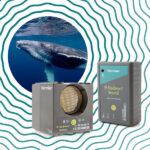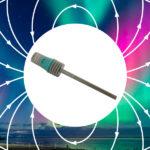
Sharing ideas and inspiration for engagement, inclusion, and excellence in STEM
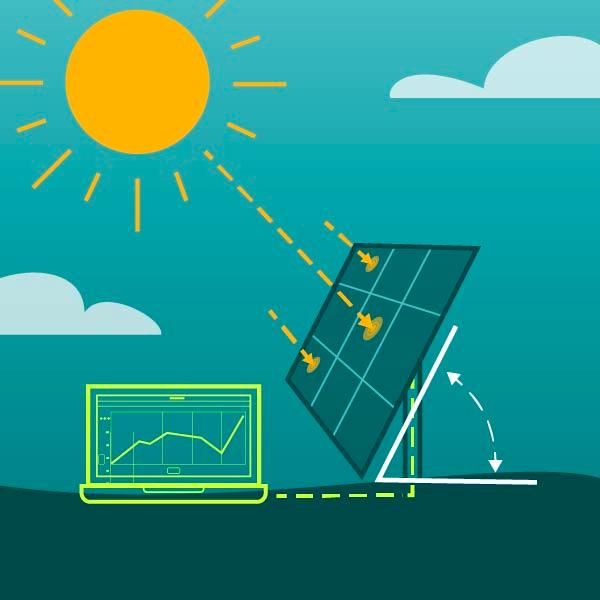
Every April, Earth Day offers a timely opportunity to explore how science and engineering intersect with the real world. This year’s theme, Our Power, Our Planet, invites students to consider the role of energy in shaping the future—and how we can use real-world data, engineering design, and problem-solving to explore cleaner, more sustainable options.
In the hands-on investigation outlined here, students use Vernier technology to explore which variables affect solar panel output. With tools like the Go Direct® Energy Sensor and KidWind solar panels, they’ll test and analyze real-time data to determine how design decisions influence performance. Along the way, they’ll build key skills in problem-solving, systems thinking, and evidence-based decision-making—all essential elements of the engineering design process and three-dimensional learning.
Exploring the Possibilities of Solar Power
A great way to kick off this activity is by asking students to brainstorm: What are some things they already know are powered by solar energy? Maybe they’ve seen panels on the school’s roof, used a solar-powered calculator or phone charger, or noticed solar lighting in their neighborhood. Starting with what they already know—and what they think is possible—helps surface prior knowledge and set the stage for deeper investigation.
To expand the conversation, consider showing a short video like this one from PBS. It follows a team of students at NC State as they convert a gas-powered Volkswagen into a solar-powered racecar using 1,300 battery cells and an electric motor.
Use the video as a jumping-off point for class discussion:
- What surprised students about the design?
- What constraints might the team have faced—budget, materials, time?
- How does scale affect solar-powered systems?
This kind of example helps make the crosscutting concept of scale, proportion, and quantity feel more concrete while introducing engineering design considerations—like budget limitations, available materials, space constraints, and performance targets. Students can begin to see that the same principles used to optimize a solar‑powered calculator (low energy draw, efficiency, compact design) also apply to much more ambitious projects, just on a different scale.
A Hands-On Investigation: Variables Affecting Solar Panel Output
Experiment #19 from Renewable Energy with Vernier
With the groundwork laid for the range and potential of different solar energy applications, students can begin to ask questions and carry out investigations into how different variables—such as panel angle, temperature, and irradiance—impact energy output. Whether used as a standalone investigation or as part of a broader design challenge, this activity, written for high school or first-year college students, can be adapted to fit a variety of student levels, timeframes, and classroom resources.
For Elementary: Investigating Solar Energy
For Middle School: Solar Energy Explorations
What You’ll Need
- Go Direct Energy
- Device with Vernier Graphical Analysis®
- Vernier Variable Load
- KidWind 2V/400mA Solar Panel (or Solar Energy Exploration Kit)
- Optional: Go Direct Light and Color and Go Direct Surface Temperature
What Students Will Do
Each group tests 3–5 modifications of at least one variable (pre-assigned or student-selected), records voltage and current, calculates power output, and analyzes the results. The goal is to isolate how one specific change affects performance—and share findings with the class to build a more complete understanding of solar energy systems.
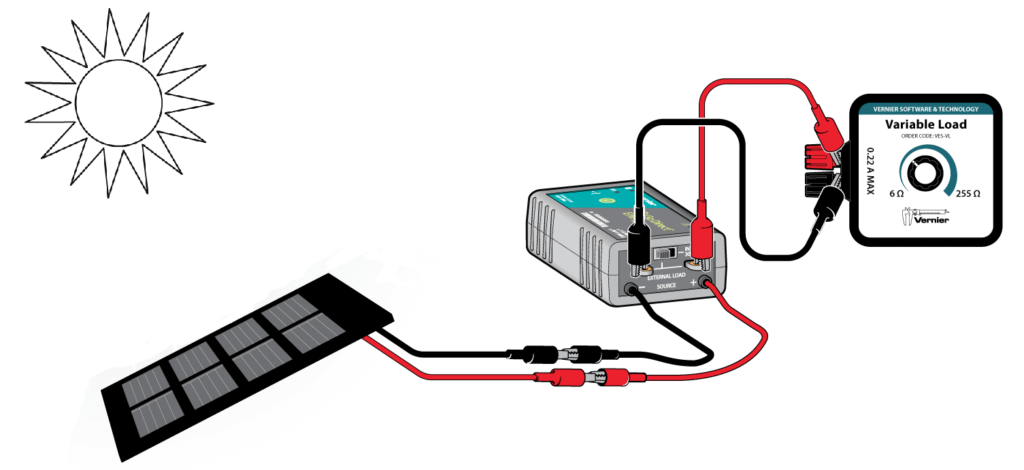
Before testing, each group should create a plan for how they want to modify their specific variable. Once the equipment is set up, they can collect sample data to confirm proper readings. If values appear negative, students should reverse the wire connections. Adjust the load until the resistance is approximately 10 Ω or optimized for your conditions.
Solar Panel Variables to Explore
- Angle to Horizon
- Orientation (North, South, East, West)
- Time of Day
- Temperature (with Go Direct Surface Temperature Sensor)
- Illumination (with Go Direct Light and Color)
- Series or Parallel Circuit with Multiple Solar Panels
As a class, you can brainstorm and chart variables ahead of time. Ask students to consider: Which variables are likely to matter most? How will they keep other conditions constant?
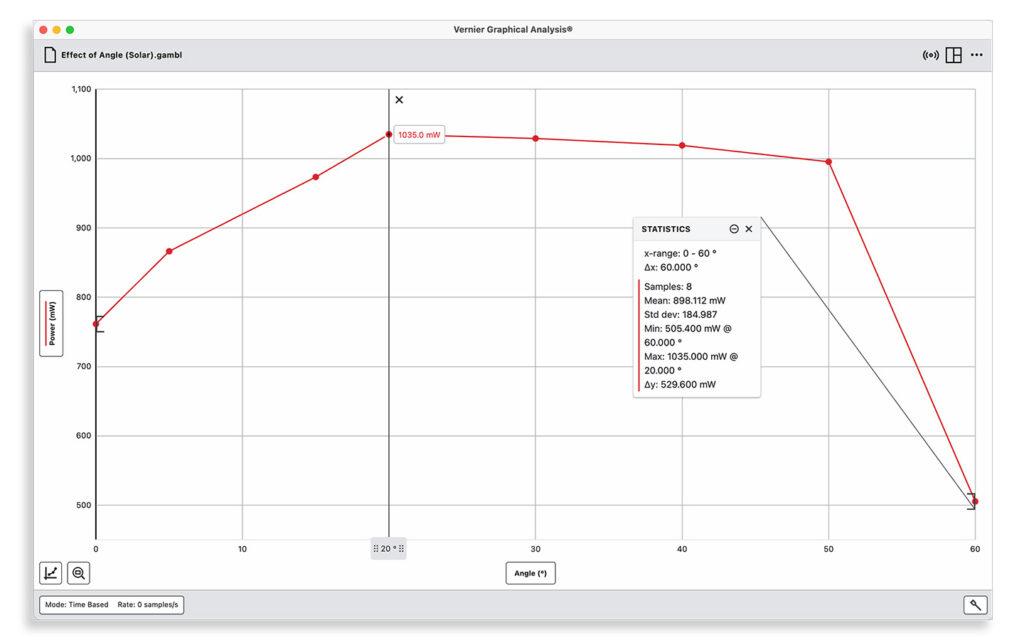
How This Experiment Supports 3D Standards
This experiment supports HS-PS3-3, which asks students to design, build, and refine a device that works within given constraints to convert one form of energy into another. Students plan and carry out investigations as well as analyze and interpret data to explore how different variables impact solar energy conversion.
By exploring how energy output is affected by design choices, students begin to recognize the role of constraints—like space, material efficiency, and environmental conditions—in optimizing systems of different scales.
Tips for Success
Keep these practical tips in mind to help your students get the most out of this investigation.
- Test one variable at a time. Encourage students to keep all other conditions constant so they can isolate the effects of their chosen variable. They might be surprised at how quantifiable a difference even very small changes can make!
- Take it outside! This experiment works best in bright, direct sunlight. Avoid collecting data through windows, as glass can filter or diffuse light. If sunlight isn’t available, a full-spectrum bulb may work with some panels—but results may vary.
- Watch for fluctuating light levels. If students are measuring light intensity (irradiance or illuminance), remind them that values may fluctuate with cloud cover or shadows. Have them record an average or take multiple readings.
Looking for More Earth Day Ideas? Join Our Upcoming Webinar!
We partnered with NSTA to bring you this free webinar, packed with hands-on strategies to teach climate science year-round and help students connect with the world around them through data‑driven discovery.
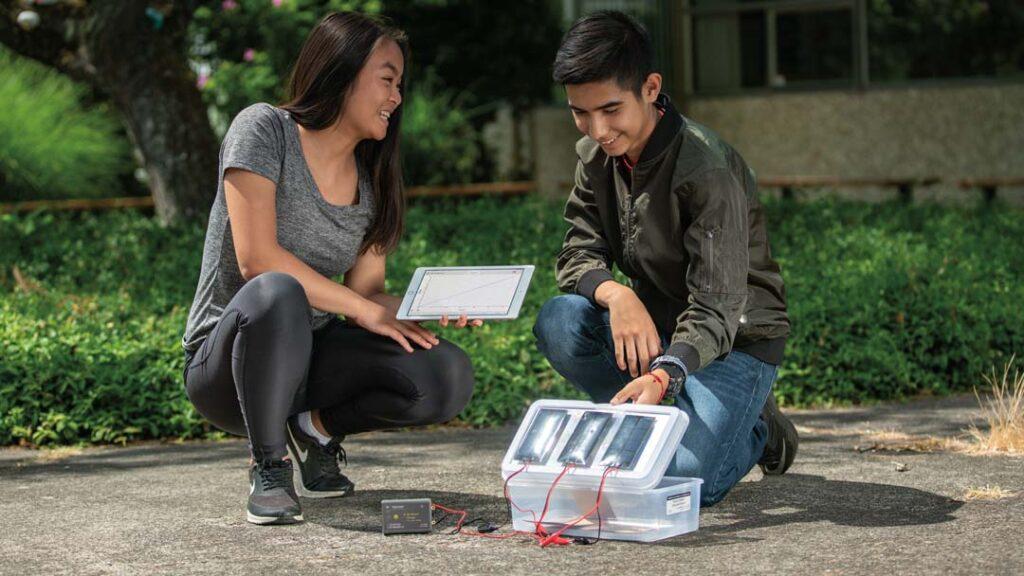
From Local Data to Global Phenomena: Hands‑On Climate Science Investigations
Monday, April 21
5:00–6:00 p.m. PDT | 8:00–9:00 p.m. EDT
Register Today
Do you have innovative ways of teaching renewable energy with Vernier? Let us know at blog@vernier.com or share with us on social! Questions? Reach out to kidwind@vernier.com, call 888-837-6437, or drop us a line in the live chat.
Share this Article

Sign up for our newsletter
Stay in the loop! Beyond Measure delivers monthly updates on the latest news, ideas, and STEM resources from Vernier.





